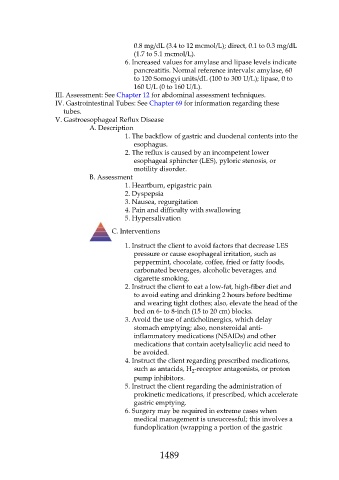Page 1489 - Saunders Comprehensive Review For NCLEX-RN
P. 1489
0.8 mg/dL (3.4 to 12 mcmol/L); direct, 0.1 to 0.3 mg/dL
(1.7 to 5.1 mcmol/L).
6. Increased values for amylase and lipase levels indicate
pancreatitis. Normal reference intervals: amylase, 60
to 120 Somogyi units/dL (100 to 300 U/L); lipase, 0 to
160 U/L (0 to 160 U/L).
III. Assessment: See Chapter 12 for abdominal assessment techniques.
IV. Gastrointestinal Tubes: See Chapter 69 for information regarding these
tubes.
V. Gastroesophageal Reflux Disease
A. Description
1. The backflow of gastric and duodenal contents into the
esophagus.
2. The reflux is caused by an incompetent lower
esophageal sphincter (LES), pyloric stenosis, or
motility disorder.
B. Assessment
1. Heartburn, epigastric pain
2. Dyspepsia
3. Nausea, regurgitation
4. Pain and difficulty with swallowing
5. Hypersalivation
C. Interventions
1. Instruct the client to avoid factors that decrease LES
pressure or cause esophageal irritation, such as
peppermint, chocolate, coffee, fried or fatty foods,
carbonated beverages, alcoholic beverages, and
cigarette smoking.
2. Instruct the client to eat a low-fat, high-fiber diet and
to avoid eating and drinking 2 hours before bedtime
and wearing tight clothes; also, elevate the head of the
bed on 6- to 8-inch (15 to 20 cm) blocks.
3. Avoid the use of anticholinergics, which delay
stomach emptying; also, nonsteroidal anti-
inflammatory medications (NSAIDs) and other
medications that contain acetylsalicylic acid need to
be avoided.
4. Instruct the client regarding prescribed medications,
such as antacids, H -receptor antagonists, or proton
2
pump inhibitors.
5. Instruct the client regarding the administration of
prokinetic medications, if prescribed, which accelerate
gastric emptying.
6. Surgery may be required in extreme cases when
medical management is unsuccessful; this involves a
fundoplication (wrapping a portion of the gastric
1489

